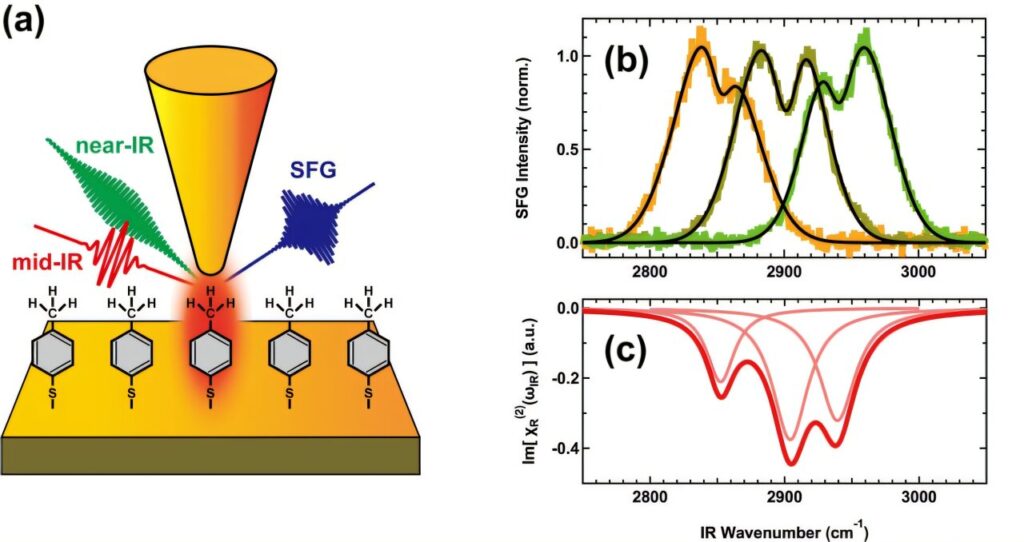Vibrational sum-frequency generation (VSFG) is a nonlinear spectroscopic method widely used to investigate the molecular structure and dynamics of surface systems. However, in far-field observations, the spatial resolution of this method is constrained by the diffraction limit, which restricts its ability to resolve molecular details in inhomogeneous structures smaller than the wavelength of light.
To address this limitation, researchers, Atsunori Sakurai, Shota Takahashi, Tatsuto Mochizuki, and Toshiki Sugimoto, Institute for Molecular Science (IMS), NINS, developed a tip-enhanced VSFG (TE-SFG) spectroscopy system based on scanning tunneling microscopy (STM). Using this system, the team detected VSFG signals from molecules adsorbed on a gold substrate under ambient conditions.
The research is published in the journal Nano Letters.
Phase analysis of the interferometric VSFG spectra provided insights into the molecular orientation. Furthermore, the observed VSFG signals were confirmed to originate from a highly localized region within the gap between the STM tip apex and sample substrate.
Thus, this method offers an innovative platform for nonlinear optical nanospectroscopy, enabling the investigation of surface molecular systems beyond the diffraction limit.
VSFG spectroscopy is a powerful technique for investigating molecular structures and dynamics of surface systems. In this method, a sample is simultaneously irradiated with infrared (IR) light that is resonant with molecular vibrations and visible or near-IR light at a different frequency.
The resulting light, corresponding to the sum of the two input frequencies, reveals vibrational signatures unique to specific molecular species.
A unique advantage of VSFG spectroscopy is its surface sensitivity, which enables the selective detection of molecules at interfaces. This capability has established VSFG spectroscopy as a powerful tool in surface science.
This technique can also reveal the absolute orientation of molecules—whether they are oriented upward or downward relative to a given surface. This information is critical because molecular orientation often influences chemical reactivity and functionality.
Moreover, VSFG spectroscopy uses femtosecond laser pulses, which allow it to capture ultrafast nuclear motion, thereby facilitating detailed studies of dynamic molecular processes.
However, conventional far-field VSFG spectroscopy is constrained by the diffraction limit of light, which restricts spatial resolution to the sub-micrometer scale. Consequently, the measured signals typically represent averaged responses from ensembles of more than a million molecules.
To address this limitation, spectroscopic techniques have been combined with scanning probe microscopy (SPM). Notably, when light is confined within the nanogap formed between the SPM tip and sample surface, it generates a highly localized optical near-field. Scanning near-field optical microscopy exploits this phenomenon to achieve nanoscale resolution.
In this study, the researchers successfully integrated femtosecond-pulse VSFG spectroscopy with scanning tunneling microscopy (STM). Specifically, by focusing mid-IR and near-IR pulses into the nanogap between the STM tip and substrate, VSFG signals emitted by molecules adsorbed on the surface were detected.
When the tip and substrate were separated by 50 nm, almost no signal was observed. However, as the tip and substrate were brought closer in the tunneling regime, a significant VSFG signal emerged, highlighting the critical role of near-field enhancement.
By tuning the mid-IR wavelength and acquiring eight different spectra, the researchers identified three characteristic vibrational features corresponding to the terminal methyl group in the adsorbed molecules: symmetric stretching; a Fermi resonance between the bending overtone and the symmetric stretching mode; and asymmetric stretching.
Furthermore, the signal disappeared when the tip-substrate distance exceeded 1 nm, indicating that the VSFG signal originated from a region confined within 1 nm of the surface.
This extreme spatial confinement was realized through two synergistic effects: the antenna effect, which focuses IR light on the tip apex, and plasmonic enhancement in the nanogap, which increases the emission efficiency of visible VSFG signals.
These synergistic field enhancements played a crucial role in enabling the detection of signals from a very limited number of molecules within the nanogap.
Additional analysis revealed a negative imaginary component of the second-order susceptibility, indicating that the terminal methyl groups were oriented such that their hydrogen atoms pointed away from the substrate. This finding confirmed that the technique could determine molecular orientation in highly localized regions.
Overall, this study demonstrates the successful detection of VSFG signals from a very limited number of molecules confined within nanoscale gaps, originating from regions less than 1 nm in size.
This breakthrough paves the way for next-generation techniques, including single-molecule ultrafast spectroscopy and ultra-high-spatial-resolution molecular imaging.
These capabilities are expected to provide new insights into surface chemical processes, particularly in heterogeneous catalysis, and facilitate the rational design of highly active catalytic materials.


